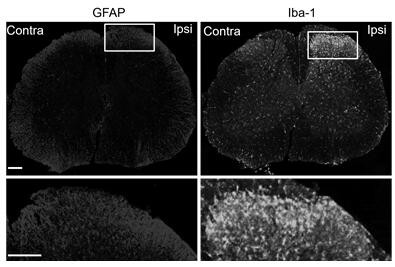Application of HAP1 in screening neuroinflammation treatment drugs
A technology for neuroinflammation and drug treatment, applied in the field of biomedicine, can solve the problems of reducing the quality of life of patients, unclear mechanism of occurrence and development, and complex etiology of neuropathic pain.
- Summary
- Abstract
- Description
- Claims
- Application Information
AI Technical Summary
Problems solved by technology
Method used
Image
Examples
Embodiment 1
[0026] 1. Neuropathic pain can induce neuroinflammation
[0027] HAP1 wild-type mice were used to construct an acute pain model, and slices were obtained, followed by immunofluorescence staining.
[0028] GFAP and Iba-1 are specific markers for astrocytes and microglia, respectively. figure 1 The staining results showed that compared with the control side spinal cord, the surgical side spinal cord showed significant glial cell activation phenomenon. This result suggests that neuropathic pain can induce neuroinflammation.
[0029] 2. Low expression of HAP1 can inhibit the activation of glial cells
[0030] The acute pain model was constructed from HAP1 heterozygous mice, and the slices were taken and then subjected to immunofluorescence staining.
[0031] GFAP and Iba-1 are specific markers for astrocytes and microglia, respectively. figure 2The staining results showed that glial cell activation also occurred in the spinal cord of the operated side compared with the contro...
PUM
 Login to View More
Login to View More Abstract
Description
Claims
Application Information
 Login to View More
Login to View More - R&D
- Intellectual Property
- Life Sciences
- Materials
- Tech Scout
- Unparalleled Data Quality
- Higher Quality Content
- 60% Fewer Hallucinations
Browse by: Latest US Patents, China's latest patents, Technical Efficacy Thesaurus, Application Domain, Technology Topic, Popular Technical Reports.
© 2025 PatSnap. All rights reserved.Legal|Privacy policy|Modern Slavery Act Transparency Statement|Sitemap|About US| Contact US: help@patsnap.com



